
home \ courses \ music theory II \ page 2
The unison
The unison is an interval from one to the same letter. E.g. From C to the same C is an unison.
Perfect unison
When the pitch of the tones is the same (in music theory this is called "enharmonic the same"), the unison is a perfect unison.
Examples: C-C, E-E, Bb-Bb, G#-G# are all perfect unisons.
Diminishes unison
There are situations where the pitch is not the same. E.g. there is a Bb and a B.
The letters are the same, but the pitch of the second tone, the Bb is lower than the B.
In this case, we speak of the diminished unison.
An example in real life would be a pianoplayer plating the B as the highest note in a G7 chord. The solo guitar could play a bluesy Bb on that. B-Bb: a diminished unison.
Augmented unison
In an other situation you could have e.g. a G and a G#. In that case the second one sounds higher. We call that an augmented unison.
Audio examples of the unison

Respectively a perfect, diminished and augmented unison
The second
The second is an interval from one letter to the next letter, so one letter. E.g. C-D, F-G, A-Bb, E-F, or G#-A, etc.
There are four types of seconds:
Types of seconds
- Major second: the distance is one whole tone. E.g. C-D, D-E, G-A, F#-F#.
- Minor second: the distance is a semitone. E.g. C-Db, D-Eb. E-F. G#-A.
- Diminished second: the distance is zero, no tone. E.g. C#-Db. D#-Eb, G#-Ab.
- Augmented second: the distance is one and a half tone. E.g. C-D#, F-G#, Ab-B.
So sometimes the distance between tones is the same, but the name of the interval is different, because other letters are used. Some examples:
- An augmented unison (C-C#) sounds the same as a minor second (C-Db)
- A perfect unison (D#-D#) sounds the same as a diminished second (D#-Eb)
- Looking forward to the third: a minor third (C-Eb) sounds the same as an augmented second (C-D#)
Audio examples of the second

Respectively a major, minor, diminished and augmented second
The third
The third is a distance of two letters, e.g. C-E, D-F, G-B.
The third is a very important interval,as mentioned in the previous course about scales.
Just as the second, the third can be major, minor, diminished or augmented.
The two important types however are major and minor. We tend to experience major as cheerful, while minor gives us a more melancholic experience.
Types of thirds
- Major third: the distance is two whole tones. E.g. C-E, D-F#, G-B, F#-A.
- Minor third: the distance is one and a half tone. E.g. C-Eb, D-F. E-G. G-Bb.
- Diminished second: the distance is one tone. E.g. E-Gb. B-Db.
- Augmented second: the distance is two and a half tone. E.g. F-A#, Ab-C#.
Again, some thirds sound the same (are enharmonic equal) as other intervals. This overlap exists for all intervals that are "next to each other" (unison and second, second and third, third and fourth, etc.).
Audio examples of the third

Respectively a major, minor, diminished and augmented second
<<< Previous page | Next page >>>

Everything on guitartutorials.nl is completely free to access. If you’d like to support my work and help keep this resource growing, any and all donations are deeply appreciated. Thank you, and happy playing!